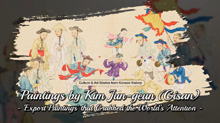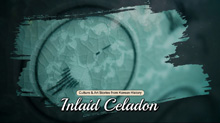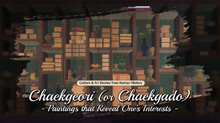The Story of Culture and Arts
- Image resource of Korean history
- Documents from History TextBooks
- Culture & Art Stories from Korean History
- Culture & Art Stories from Korean History - Korean
- National Institute of Korean History
- History net
- About the site
- Introduce
-
Numerous topics related to Korean culture and art are mentioned in middle and high school national history textbooks, but most of them are briefly described by era, making it difficult to understand their concepts, transition processes, and characteristics.
<Culture & Art Stories from Korean History> produces and provides video materials based on expert commentary on the flow, change process, characteristics and characteristics of each major topic in the field of culture and art in Korean history.

Scenario
The unusual forest-green background stands out. The Western-style use of perspective provides depth. With the use of shadowing, the bookcase appears three-dimensional. In addition to the books, one sees a vase of apricot blossoms, writing implements, carp-shaped decorations, and other items.
Here, do you see that seal in its case?
It reads “Yi Eung-rok,” the name of Korea’s premier chaekgeori artist and the creator of this painting.
The Appearance of Chaekgeori
Korea’s premier style of still-life painting, chaekgeori. Also called chaekgado, these paintings showcased not only books but all items in one’s personal study. In a single painting, we view the tastes of mainly the male aristocracy—a varied array of items, from books, ink, and brushes to porcelain and antiques.
The vibrant colors of the chaekgeori were a stark contrast to the black and white of ink paintings and a prominent feature of their style. They were usually painted on multi-panel folding screens and decorated rooms in the late Joseon period.
The late Joseon period saw growth in the country’s trade and consumer economy, which in turn encouraged the consumption of artwork and luxury goods.
During the trend of collecting books and antiques, chaekgeori paintings worked as a way of showing off a collector’s eye and taste. Korean royalty and literati so adored the chaekgeori that court painters were required to be proficient at painting them.
King Jeongjo was so enamored by them, he replaced the Irwol obongdo, the painting traditionally symbolizing the king, with a chaekgeori.
“Good sirs, do you also see this?”
“We do, your majesty.”
“Do you really take them for ‘books’? These are not books but merely a painting.”
- Hongjae jeonseo (Collected Works of King Jeongjo), 1799
There were three major styles of chaekgeori paintings:
The ‘bookshelf style,’ with books and items arranged on bookshelves, the ‘arranged style,’ with objects placed freely in a space, and the ‘table style,’ with books and objects completely covering a table.
The bookshelf style also included paintings that only had books filling a bookshelf. This style was the first to trend in the palace. Interestingly enough, this chaekgeori painting even features a draped curtain.
Beneath the curtain, there is an eight-section bookshelf and several objects. On the bottom shelf is an open door, behind which books can be seen, making the viewer assume more books must lie behind the closed doors.
While chaekgeori paintings began in the palace, they soon spread to the literati.
“Among the upper class, there is not a home that does not have a [chaekgeori] painting adorning its walls.” - Ilmonggo (book of biographies by the 18th-century scholar Yi Gyu-sang), vol. 12
This unique chaekgeori painting depicts a leopard skin hung across a canvas. At the time, leopard and tiger fur were a sign of wealth and were thought to possess the power to ward off ghosts. One side of the fur is lifted to expose the room behind the curtain, arousing the viewer’s curiosity.
An elegant tea set, antique bronzeware, a set of Chinese dominoes lying beneath the desk, and a pair of eyeglasses resting on an open book give the impression that someone has just left the room after reading.
Early three-dimensional chaekgeori paintings gradually gave way to free-form-style paintings that destroyed perspective representation.
Chaekgeori also became a trend among the commoner class, which led to folk chakgeori. Large chaekgeori folding screens in scholars’ studies were scaled down to fit smaller homes, and thus objects were stacked to fit on the smaller canvas. Folk chakgeori were painted with many small objects freely placed on tables instead of bookshelves.
While previous chaegeori displayed scholars’ outlooks and tastes, folk chaekgeori were filled with commoners’ private desires. Watermelons, eggplants, and grapes full of seeds represented fertility, and peaches, the fruit of a Daoist hermit, symbolized a long life.
A painting of a dragon and a toad surrounding books is filled with wishes of fertility and success. Chaekgeori containing women’s items, such as a skirt, a jeogori jacket, a sewing basket, and scissors were also painted.
Chaekgeori paintings were a long-running trend, popular in private homes until the 20th century. Their long-lasting popularity could be because these paintings vividly captured the various tastes and desires of the people of the day.
-------------------------------------
Advisor: Yoo Jaebin
Script/Storyboard: Lee Na-kyeong
Editor: Kim Sujin, Myung Jaerim, Seo Myungwon
Narrator: Mary Katherine Chadwick
Filming: Yoon Jongwon
General Editing: Park Injoon, Lee Seungsin
Illustrations: Kim Jongseok, Shim Hui-young
Recording/Music: Jo Donghyo
Logo: Min Seung-ook
Materials/Resources: Leeum Museum of Art, National Folk Museum of Korea, National Museum of Korea, Chosun Minhwa Museum, National Palace Museum
English Translation & Editing: Mary Katherine Chadwick, Daniel Kane, Lee Jaeyeol
Production Manager: Yoon Jongwon, Kim Kiwon
Administration: Kim Sanghee
Director: Yoon Jongwon
Life & Folklore
22 films-
 Paintings by Kim Jun-geun(Gisan)05:15
Paintings by Kim Jun-geun(Gisan)05:15 -
 Moon Jars03:56
Moon Jars03:56 -
 Inlaid Celadon04:13
Inlaid Celadon04:13 -
 Chaekgeori (or Chaekgado)04:38
Chaekgeori (or Chaekgado)04:38 -
 Earthenware08:28
Earthenware08:28 -
 Taenghwa, or Buddhist Paintings in the Joseon Period08:36
Taenghwa, or Buddhist Paintings in the Joseon Period08:36 -
 Lacquerware09:04
Lacquerware09:04 -
 Dyeing and Weaving08:21
Dyeing and Weaving08:21 -
 Royal Seal, Eobo07:53
Royal Seal, Eobo07:53 -
 Folk paintings07:49
Folk paintings07:49 -
 Korean Genre Paintings10:05
Korean Genre Paintings10:05 -
 Paintings of the Procession of the Joseon Tongsinsa10:09
Paintings of the Procession of the Joseon Tongsinsa10:09 -
 Dongjong, Bronze Bells of Korea08:50
Dongjong, Bronze Bells of Korea08:50 -
 Calligraphy08:32
Calligraphy08:32 -
 White Porcelain08:18
White Porcelain08:18 -
 Buncheong Ware07:48
Buncheong Ware07:48 -
 Goryeo Celadon07:54
Goryeo Celadon07:54 -
 Buddhist Paintings of the Goryeo Dynasty07:57
Buddhist Paintings of the Goryeo Dynasty07:57 -
 Clay Figures, Figurines07:01
Clay Figures, Figurines07:01 -
 Clay Earthenware06:05
Clay Earthenware06:05 -
 Paintings of the Joseon Dynasty08:09
Paintings of the Joseon Dynasty08:09 -
 Statues of the Buddha in Korea09:03
Statues of the Buddha in Korea09:03

